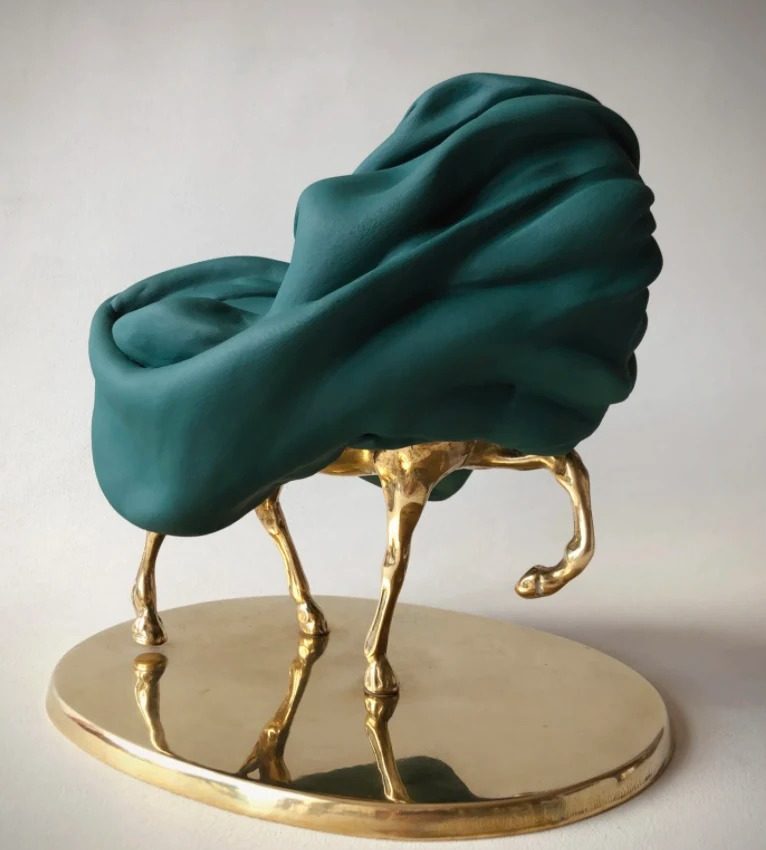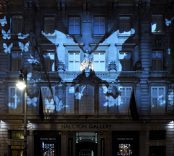Fluid stone that ripples like fabric, veils of stone that hide the statues underneath.
A Splendour Among Shadows is a curious exhibition that brings together sculptor Richard Stone and Spanish painter Lorena García Mateu. Titled after Percy Bysshe Shelley’s sonnet “Lift Not the Painted Veil”, both artists explore intertextual narratives, expectations and history, but the question must be asked how the individual successes of each artist led to what is a rather awkward pairing.
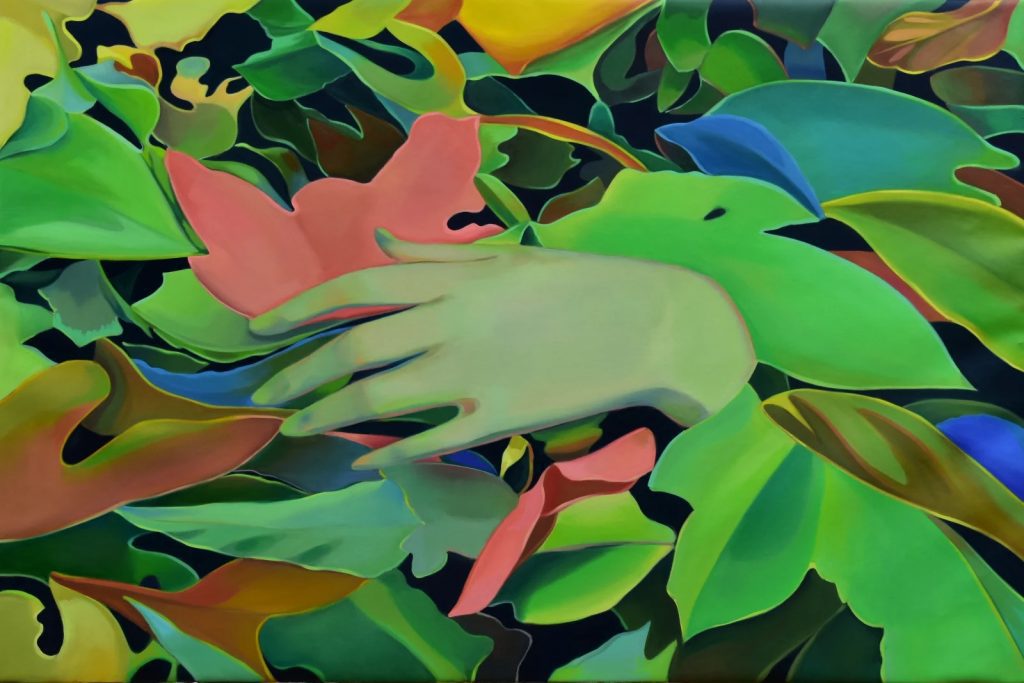
Richard Stone has been a strong card in Kristin Hjellegjerde Gallery’s stable for a number of years and his work around statues and public emblems continues to evolve. Perhaps for the first time in a long time statues, a forgotten or dead genre of art according to Jonathan Jones, have appeared in public discourse due to their reappraisal as part of the broad discussion on race and history around the world. Stone’s work shares a focus on the historicity of statues with the BLM movement, however his references to political or national iconography are broader, perhaps more existential.
The flag-like sculpture Only From the Ruins Will You Be Free is said to ‘transcend the nationalistic associations of the flag… allowing us to contemplate the object anew’ and would like us to see movements caught in the moment and immortalised as stone. Though as the title suggests, things that appear permanent are often static echoes of a moment rather than dynamic representations of an ongoing reality. In this case ‘transcend’ might be better understood to mean a deep relational investigation rather than going over or putting aside.

We see a flag caught in a moment but that isn’t to say that the work is frozen, it feels alive and flowing; we sense the taut pull of the breeze but it is written in stone. A heavy description of a light concept, the work floats on a wave of semiotic associations and processes. Flags aren’t just nationalistic symbols, they are signposts for collective identities: anarchists, religions, even football teams. They are also mediums of communication; for instance a white flag is a symbol of surrender or the medium of semaphore. If we break down the components of a flag, how much is really about ‘king and country’, and how is that meaning carried in the fabric, the colour or the shape? And to whom? Most of us don’t think about flags until they are presented to us. They are only meaningful to those who work in a field directly related to the industry of nation — royalty, defence, government — or wish to make that association, which Stone does.
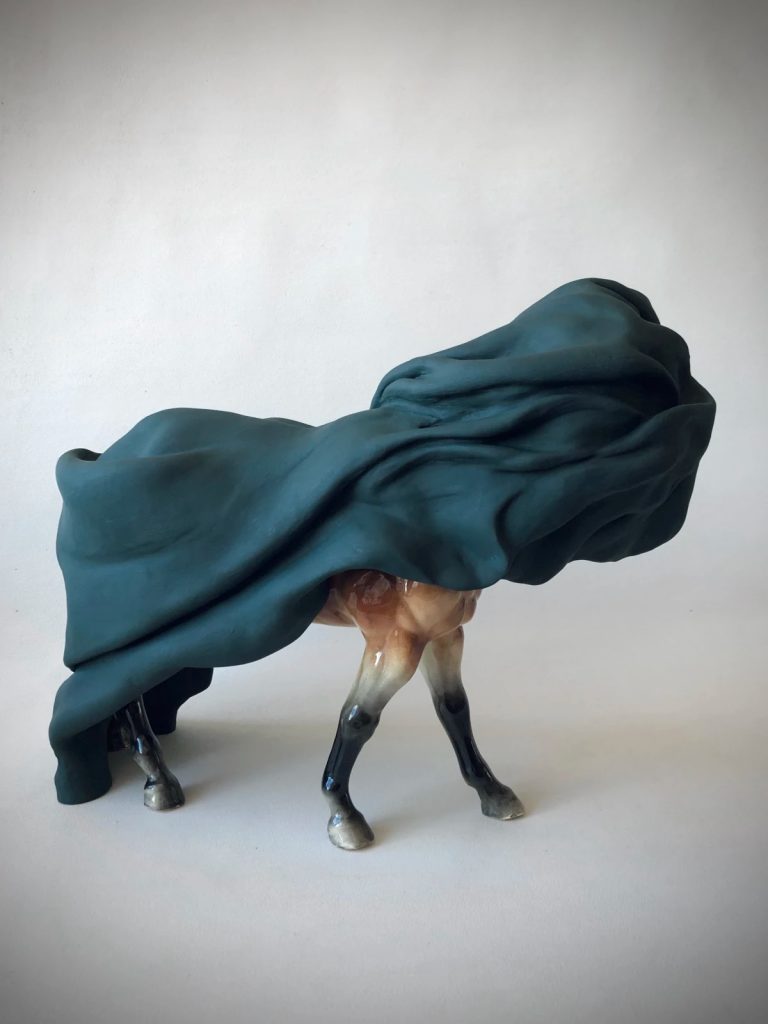
In Stone’s efforts to force us to consider forgotten public artworks, the viewer is asked to unpack what their relationship to nationalism is and the level to which we ignore the consequences of our overarching flag, collective identity, and national system. In our daily lives we are sold liberal ‘transcendence’ within a blinkered anti-flag existence that does not consider the macro ramifications of our individual actions. What will happen if we can only buy things from Amazon because all the local shops have closed? Stone is not selling us transcendent escapism, he is selling us participant freedom through investigation. He wants us to ask, ‘What collective world do we want?’ The blank flag is both ready to be painted anew and also a vacuum of national meaning.

The semantics of the work’s title are also ripe for interpretation. What is the nature of ‘the ruins’? Only ‘away’ from the ruins will one experience freedom? Or perhaps the freedom one might experience is limited to that of the lack of ruins, not total freedom, and not without new or erstwhile slaveries. People are stuck in flags as much as they follow them. What does the Union Jack mean for a refugee?
One of the delights in Stone’s work is that he is asking quite pointed social questions within works that appear polite. They are beautiful explorations of fluid movement in a hard medium and are noteworthy pieces within contemporary sculpture, and yet you have to ask whether they would be better on a bigger scale.
Sculpture has the benefit of being a three-dimensional medium which allows the viewer to have a spatial relationship with the works, and by being able to see it from different angles, it has an immediate physical intimacy. Smaller works dull that sense by becoming more two-dimensional when limiting the ways they can be viewed. Stone’s wall sculptures play with this concept in a more direct fashion where they can only be seen straight on. Stone happily sacrifices these dimensions because the works are not so much sculptures as artworks that refer to sculpture, even if the medium itself is sculpture and the artist a technical sculptor. For instance, it would be possible to make the same statements as Stone does without being aware of how light changes sculptures or even without such skilfully execution.
Alongside Stone’s sculptures, Lorena García Mateu’s febrile depictions of flowing abstractions are described as ‘a timely exploration of sensuality and artistic representation’. Striking canvases of plant or fabric abstract shapes explode across the room with swirls of vibrant colour, and emerging from each of these psychedelic arrangements, classically formed hands appear.
It’s a diverting game trying to pick which Old Masters the hands were drawn from and what the reference is between those old paintings and the works’ titles. The artist suggests that, ‘I asked myself what would happen if I dispensed with everything in the image except hands. Would it reveal some specific meaning?’
Sure, but humans are drawn to looking for the human referent in what we see, and ascribing intent to human figures is what we do. So finding meaning is a given regardless of the source. Moreover, taking hands from Old Masters is ensuring that they will have some meaning; those elder artists rarely left much to chance. The bigger question is whether this is really worth asking.
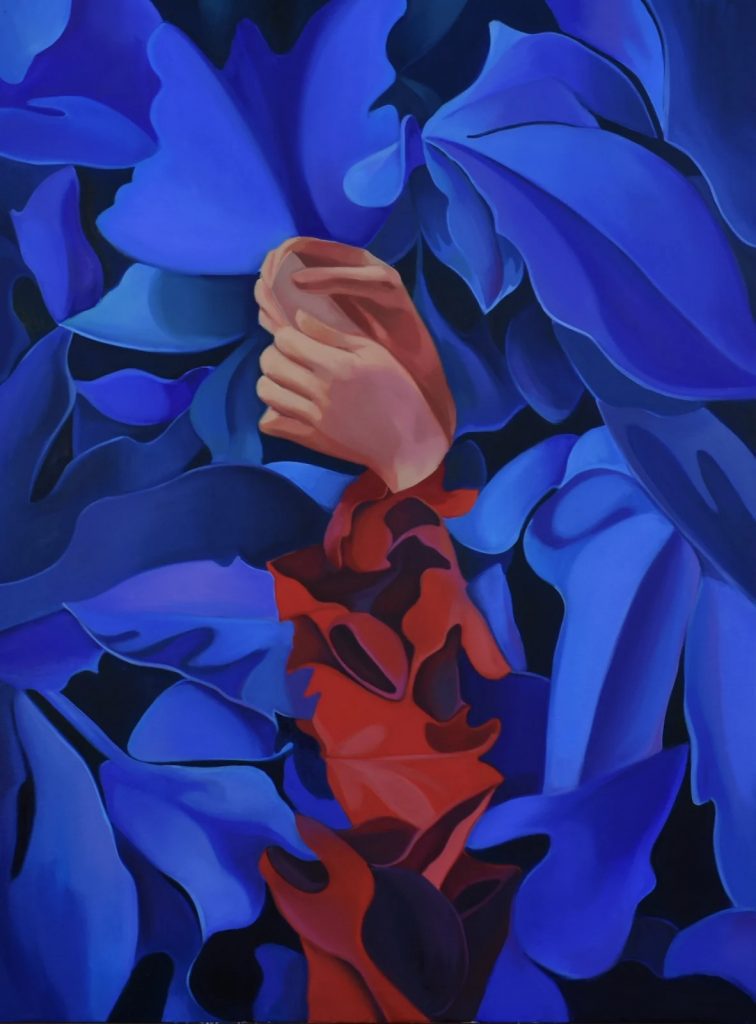
The surreal juxtaposition of hands against beautifully detailed backgrounds makes interrogative use of art history but makes a softer point than the originals, and thus mutes the work. The idea of meditations on past hands has a nice ring to it but doesn’t pack the punch necessary to pursue a fulfilling argument. The paintings are undoubtedly beautiful but do not capture the essential character of their sources, nor offer us much new. It feels mean to admit it but the abstract backgrounds, form and colour choices employed by García Mateu are of greater interest than the disembodied hands, which detract from the mesmerising effect of her powerful backgrounds.
The curatorial choice in presenting these two artists together works in theory, however when placed together in a room there is a clash. The mass of sinewy, fluid shapes in the exhibition seems like a visual pairing rather than a conceptual one, and as such doesn’t sit right; the two drag each other into the uncanny valley of being neither too specific nor too different. There might be a perverse charm in seeing a group exhibition of works inspired by (and limited to) the colour blue, water, and whales, where a panoply of crashing sapphire whales and foaming ultramarine would drench the senses. Against a template of Wet Saxe and Blowholes, the personality of each artist would be writ large. Here, they seem to pull against each other.
Worth seeing? Yes. This is some of Stone’s best work and while painting might be represented faithfully online, sculpture operates physically, meaning this is a rare chance to experience the work before it heads into private hands. García Mateu’s work has some strong moments and where the disparate elements come together, there is a remarkable shock of clarity. Her colour combinations are worth studying; as well as being often complementary they regularly invert positive and negative space to startling effect. Just what we need as the year darkens over London.
A Splendour Among Shadows runs at Kristin Hjellegjerde Gallery’s London Bridge space until 19 September 2020.
www.richardstoneprojects.com
kristinhjellegjerde.com

The aim of art is to represent not the outward appearance of things, but their inward significance. – Aristotle

